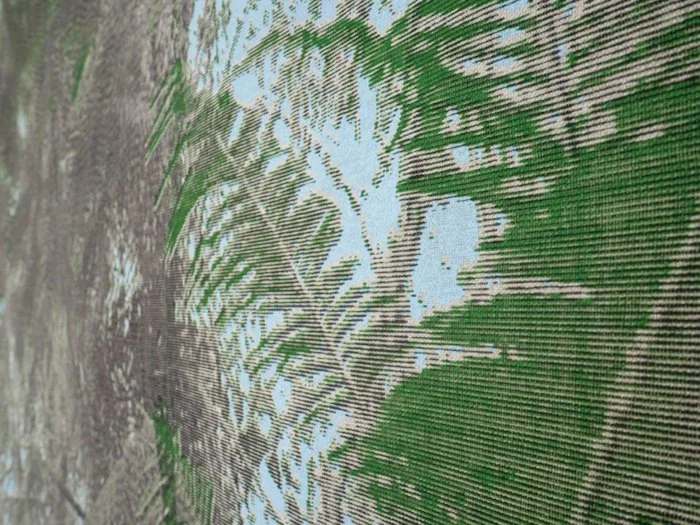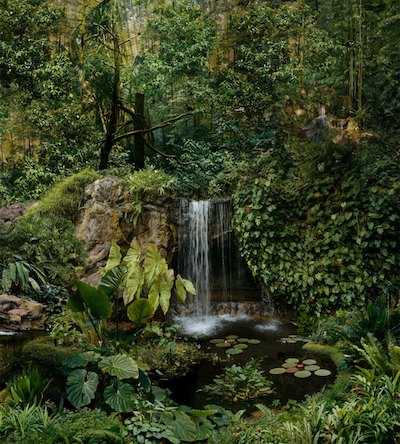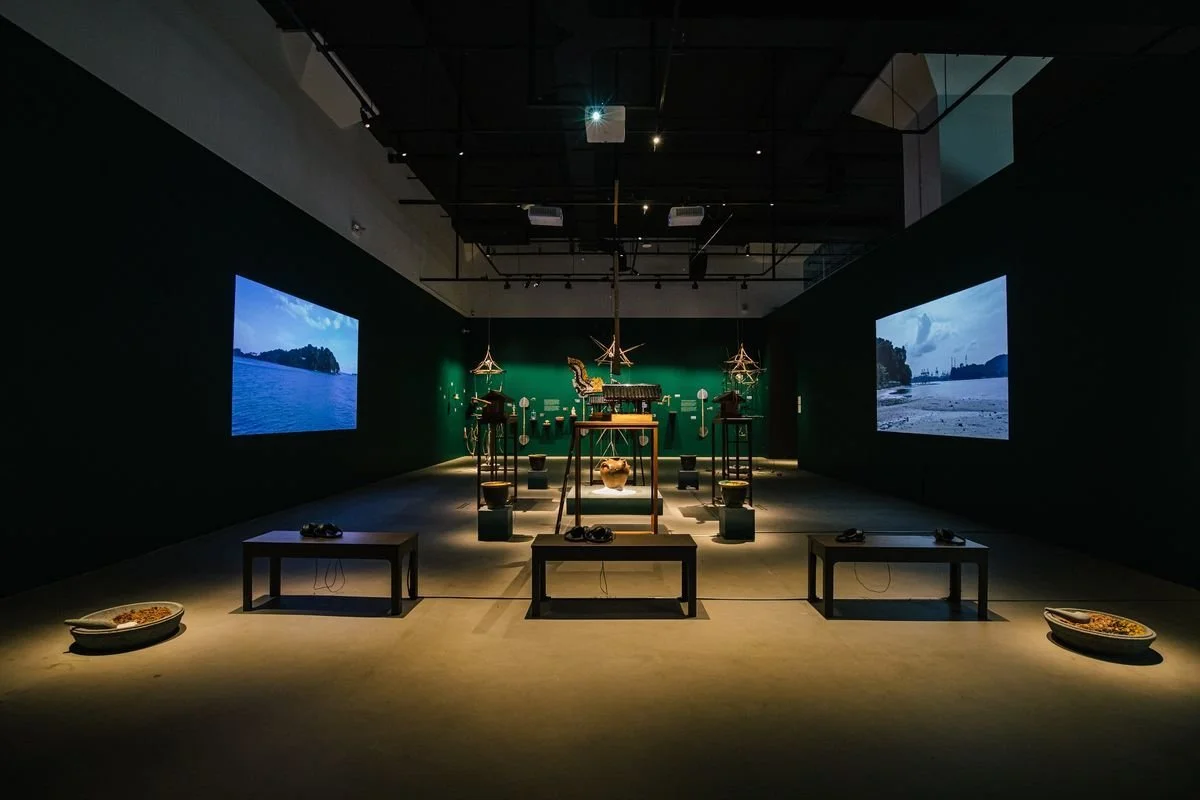Three Brief Notes on an Equatorial Theme: Exploring the Tropical Imaginary in Recent Singapore Art
Kent Chan, Donna Ong, Zarina Muhammad, Joel Tan, Zachary Chan
Kent Chan, detail of still film, 2019, silk screen on fabric, 160 x 300cm. Image courtesy of the artist.
Between the crab and the goat, the air shimmers with a moist heat where an imaginary line cuts the Earth in half.
Here, the rain falls like sunlight and sunlight falls like rain and ice is a trick of height.
Here, wetness clings like a lover, tracing your contours with brine-scented kisses on your secret places.
Here, green is green is the ever-present shadow of a blue as gazed from the seas.
Those who came with the waves, who looked upon the shore with awe and contempt, have the horizon quivering behind them as they began with the first acts of fabulous violence. Thrilling us softly with whispered promises, killing us softly with breathless words, the camera on the ship thrums with the same energy as pen over paper, knife over neck.
What is written, what is taken, what is documented; this is a pronouncement, a sentence, a sentence for the people who will be under new kings and queens: let there be might.
I. Arts of a certain trope with Kent Chan at NUS Museum, 2019
I am reading a poem for the exhibition launch and wondering if I should have sung instead. I am reading a poem and the words flow out syrup-viscous, heavy with history. Twenty meters above me, landscapes by pioneers of the Nanyang style surround an enclosure of three screens and coloured glass. Outside, a banner hangs, a film still silk-screen printed onto a gauzy cloth. On screens, a boy in a boat sings me my same poem.
We glide over the lushness of rainforests as we hear a story of a pioneering man: Ho Kok Hoe, polymath and then-president of the Singapore Art Society who organised the first European exhibition of Singaporean art in 1955, eight years before the formation of Malaysia. Unfolding almost as an abstract opera, we navigate across different layers of narrative: landscape shots, a minimal reenactment of Ho’s journey, and the mounting of a quaint installation-exhibition in the jungle, staffed by stalwarts of the contemporary Singapore scene and artistic friends, backed by a meandering aria. At the intersection where art, history, and art history collide and collude, Chan shrewdly utilises the framework of artistic ambition as the point of departure to contemplate the invention of modernity and progress as that which colonised subjects anxiously aspire to and pursue. Has the colonial hangover really gone away? I wondered. The tropes of the tropic throbs like a bruised knee, my finger itches to press down for a frisson of pained pleasure in how by proposing a local genre, a local sensibility, all that which came after become variations of a theme. The contained becomes its own container.
“Has the colonial hangover really gone away? I wondered. The tropes of the tropic throbs like a bruised knee, my finger itches to press down for a frisson of pained pleasure in how by proposing a local genre, a local sensibility, all that which came after become variations of a theme. The contained becomes its own container.”
Around me the old masters encounter new beasts. A large vinyl print, two scrolling LED panels dispensing catchphrases deploying the standard cliches. Abundance, humidity, jungle. I kept on wondering: where did we learn these words, use these words — Seni, the title of the film, is a Malay word that is only the closest one there is in the language to what the English mean by art.
II. Tropes of a certain art with Donna Ong at Institute of Contemporary Arts Singapore, 2021
Donna Ong, My Paradise Lost, 2020, diasec print, 67 x 60cm. Image courtesy of FOST Gallery.
If Kent Chan made me think of who owns the definition of art in the tropics, then Donna Ong made me think of who owns the tropics in art. In different valencies strewn across her works, Ong mixes and remixes images of the vibrant, vegetal landscape to create composites of all that the tropic could be — and revealing in these artificialities, the subtle politics behind the legibility of the tropic as an idea and ideal, and naturally, who gets to find them legible.
Looking at My Paradise Lost, for example, Ong composes a collage of a welcoming green retreat complete with a small resplendent pond and alcove from photographs of locations from the Singapore Zoo and other local scenic spots. Here, Ong displays her characteristic semiotic sleight-of-hand in rendering a visual language of desire for a controlled and accessible form of nature that is divorced from its messy realities, a feat that is also illuminated by the work’s title, which toys with the idea of ownership and nostalgia in a register that could be either sardonic or sincere. Off in a subtle way, my eyes flow from one invisible seam in the image to another, unaware but unsettled nonetheless. I think of Milton, and his parting consolations for the fallen Adam and Eve: A paradise within thee, happier farr. What does it mean to lose a paradise — the access, the possession, or the image of it being yours? Has there ever been paradise that is not a formulation of rhetorics and nostalgia?
Throughout other works, Ong likewise shows a keen eye in excavating the historical and political economy of jungle as spaces of latent desires that can only be actualised through a colonial mechanism of discourse and extraction. Juxtaposing a collection of 19th century colour lithographs of tropical flora and fauna against a series of postcards — quite aptly titled Postcards from the Tropics—set into little installations of tchotchkes and paraphernalia, Ong furthers an inquiry into how images of the tropic become both commodity and its own constituent economy of circulation, and the inescapable ability for images to define and determine reality, often with bleak implications.
III. A Post-Green Tropic with Zarina Muhammad, Joel Tan and Zachary Chan at Singapore Art Museum, 2022
Zarina Muhammad, Joel Tan, and Zachary Chan, Dioramas for Tanjong Rimau, 2022, installation shot. Image courtesy of Singapore Art Museum.
I have not felt as in-sync with the world as I did when I first stepped into the room-scaled installation of Dioramas for Tanjong Rimau by artist-collaborators Zarina Muhammad, Joel Tan, and Zachary Chan. Oriented around the eponymous beach, a protected ecological zone located on the tourist destination of Sentosa island, renamed from its original and less foreign-public-friendly name of Pulau Blakang Mati, or the island behind which lies death, Dioramas provides a good entryway into reconsidering what are the other environments associated with the tropics, beyond the standards of trees, leaves, greenery.
Through a collection of objects, moving images, and soundscapes that evokes both native histories overwritten by the new tropes of progress and urbanisation and the sensorial qualities of a more-than-human way of being, I sense before I recognise that the contiguity of embodying the environment is intertwined with how the environment is embodied by those who occupy it. Surrounded by projections and displays, four stilted wind-up instruments occupy the center of the room, circling a vessel on a low platform. Visitors are invited to play them and make an offering by producing a warm marimba-like tune that, when played on all four instruments, bounce off the walls and each other in a sweet, rounded harmony that brings to mind a charm or a spell, ringing faintly with a certain softness that speaks to care and conviviality. Around the instruments, a murmuring rumination unfolds across three screens, each eyeing the changing coastline with a tender, if wistful, lens.
While there is much to look at in Dioramas, the part that conjures a most instinctive delight is aural. Without the baggage of text, be they orthography or image, and without reverting to the primitivist cliche of reductively sampled nature sounds, I imagine a potential out for the saturated ocular culture of the tropics we are used to consuming. The participatory nature of how the instruments are activated likewise points to a simple possibility of how to resist the hegemonic tropes of a colonial imagination through situated geopoetics — that we start by making a joyful noise with our own bare hands.
Codetta
Across these three studies on the tropical imaginary, a recurrent motif runs through like a thread, like a ghost — history and its ambivalent malleability for who gets to shape it. A painting like a film like a photograph like a land, the media of the tropics heave and sprawl with the energy of a present that yearns to make-sense and sense-make a palimpsest past. Before the visual trappings of the lush and the verdant, the tropics was first and foremost a device of geography, a subject for territory, imperial to some and imperilled to others. Through different ways that, in their own idiosyncrasies, speak to the relationality and rarefaction of the equatorial aesthetics as a matter of historical spin, these three artists undergird a fundamental truth to the contrivance of the tropics: that for all the heat, plants, and moisture there are, the tropics are but a state of mind.
This is a winning entry from the third Art & Market Fresh Take writing contest. For the full list of winners and prizes, click here.
The views and opinions expressed in this article are the author's own and do not necessarily reflect those of A&M or the prize sponsors.



